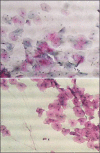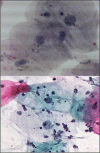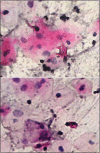Assessment of oral cytological changes associated with exposure to chemotherapy and/or radiotherapy
- PMID: 19495410
- PMCID: PMC2686222
- DOI: 10.4103/1742-6413.51332
Assessment of oral cytological changes associated with exposure to chemotherapy and/or radiotherapy
Abstract
Background: Death from cancer is high in Sudan, with low survival rates, as most of the patients present with advanced disease. Most patients receive high and repeated doses of radiotherapy or chemotherapy. The aim of this study was to investigate the feasibility of using cytological evaluation to detect oral epithelial atypia amongst these patients. As a part of the continuous development in cancer therapy, this case control study was conducted in Khartoum, Sudan.
Methods: Papanicolaou stained oral mucosal cells were obtained from 100 cancer patients receiving radiotherapy and/or chemotherapy (ascertained as cases), 50 cancer patients not exposed to either therapy (control 1), and 50 apparently healthy individuals (control 2).
Statistical analysis: The data was analyzed by using a computer SPSS program, to obtain the Chi-square test.
Results: Without prior knowledge of the subjects' group, oral epithelial atypia was detected in 7% of the cases. Inconclusive features of cytological atypia were observed in 13% of the cases. Atypia was not observed in both the control groups. Inflammatory infiltrate and viral cytopathic effects were identified in 32% and 8% of the cases respectively.
Conclusion: Cytological atypia, viral infections, and inflammatory infiltrates were detected after exposure to radiotherapy and/or chemotherapy.
Keywords: Atypia; chemotherapy; cytology; mucosa; oral; radiotherapy.
Figures



Similar articles
-
A Cytological Study Enlightening the Unseen Effects of Concomitant Chemoradiotherapy in Contralateral Normal Buccal Mucosa of Oral Squamous Cell Carcinoma Patients.Cureus. 2021 Apr 14;13(4):e14483. doi: 10.7759/cureus.14483. Cureus. 2021. PMID: 34007739 Free PMC article.
-
Effect of Fractionated Dose of Radiotherapy on Oral Mucosa in Head and Neck Cancer Patients: A Cytological Assessment.Gulf J Oncolog. 2016 May;1(21):30-5. Gulf J Oncolog. 2016. PMID: 27250885
-
Oral epithelial atypical changes in apparently healthy oral mucosa exposed to smoking, alcohol, peppers and hot meals, using the AgNOR and Papanicolaou staining techniques.Diagn Cytopathol. 2010 Jul;38(7):489-95. doi: 10.1002/dc.21224. Diagn Cytopathol. 2010. PMID: 19894260
-
Cytological study of exfoliative buccal mucosal cells of Qat chewers in Yemen.Diagn Cytopathol. 2011 Nov;39(11):796-800. doi: 10.1002/dc.21462. Epub 2010 Oct 14. Diagn Cytopathol. 2011. PMID: 20949467
-
Cervical Papanicolaou Smears in Hematopoietic Stem Cell Transplant Recipients: High Prevalence of Therapy-Related Atypia during the Acute Phase.Biol Blood Marrow Transplant. 2017 Aug;23(8):1367-1373. doi: 10.1016/j.bbmt.2017.04.022. Epub 2017 Apr 24. Biol Blood Marrow Transplant. 2017. PMID: 28450182 Clinical Trial.
Cited by
-
Chemo-radiotherapy induced oral mucositis during IMRT for head and neck cancer - An assessment.Med Oral Patol Oral Cir Bucal. 2015 May 1;20(3):e273-7. doi: 10.4317/medoral.20126. Med Oral Patol Oral Cir Bucal. 2015. PMID: 25662542 Free PMC article.
-
Assessment of cytological atypia, AgNOR and nuclear area in epithelial cells of normal oral mucosa exposed to toombak and smoking.Rare Tumors. 2009 Jul 22;1(1):e18. doi: 10.4081/rt.2009.e18. Rare Tumors. 2009. PMID: 21139889 Free PMC article.
-
A Cytological Study Enlightening the Unseen Effects of Concomitant Chemoradiotherapy in Contralateral Normal Buccal Mucosa of Oral Squamous Cell Carcinoma Patients.Cureus. 2021 Apr 14;13(4):e14483. doi: 10.7759/cureus.14483. Cureus. 2021. PMID: 34007739 Free PMC article.
-
Assessment and prevalence of concomitant chemo-radiotherapy-induced oral mucositis in patients with oral squamous cell carcinoma.Turk J Med Sci. 2021 Apr 30;51(2):675-684. doi: 10.3906/sag-2007-131. Turk J Med Sci. 2021. PMID: 33155791 Free PMC article.
-
Toluidine Blue with a Synergistic Effect in Morphological Assessment of Oral Cytosmears.J Cytol. 2018 Jan-Mar;35(1):8-14. doi: 10.4103/JOC.JOC_185_16. J Cytol. 2018. PMID: 29403163 Free PMC article.
References
-
- Johnson NW, Ranasinghe AW, Warnakulasuriya KA. Potentially malignant lesions and conditions of the mouth and oropharynx: Natural history-cellular and molecular markers of risk. Eur J Cancer Prev. 1993;2:31–51. - PubMed
-
- Bindu L, Balaram P, Mathew A, Remani P, Bhattathiri VN, Nair MK. Radiation-induced changes in oral carcinoma cells: A multiparametric evaluation. Cytopathology. 2003;14:287–93. - PubMed
-
- Bindu L, Balaram P, Mathew A, Remani P, Bhattathiri VN, Nair MK. Radiation-induced changes in oral carcinoma cells: A multiparametric evaluation. Cytopathology. 2003;14:287–93. - PubMed
-
- Mehrotra R, Goel N, Singh M, Kumar D. Radiation-related cytological changes in oral malignant cells. Indian J Pathol Microbiol. 2004b;47:343–7. - PubMed
LinkOut - more resources
Full Text Sources
Research Materials

